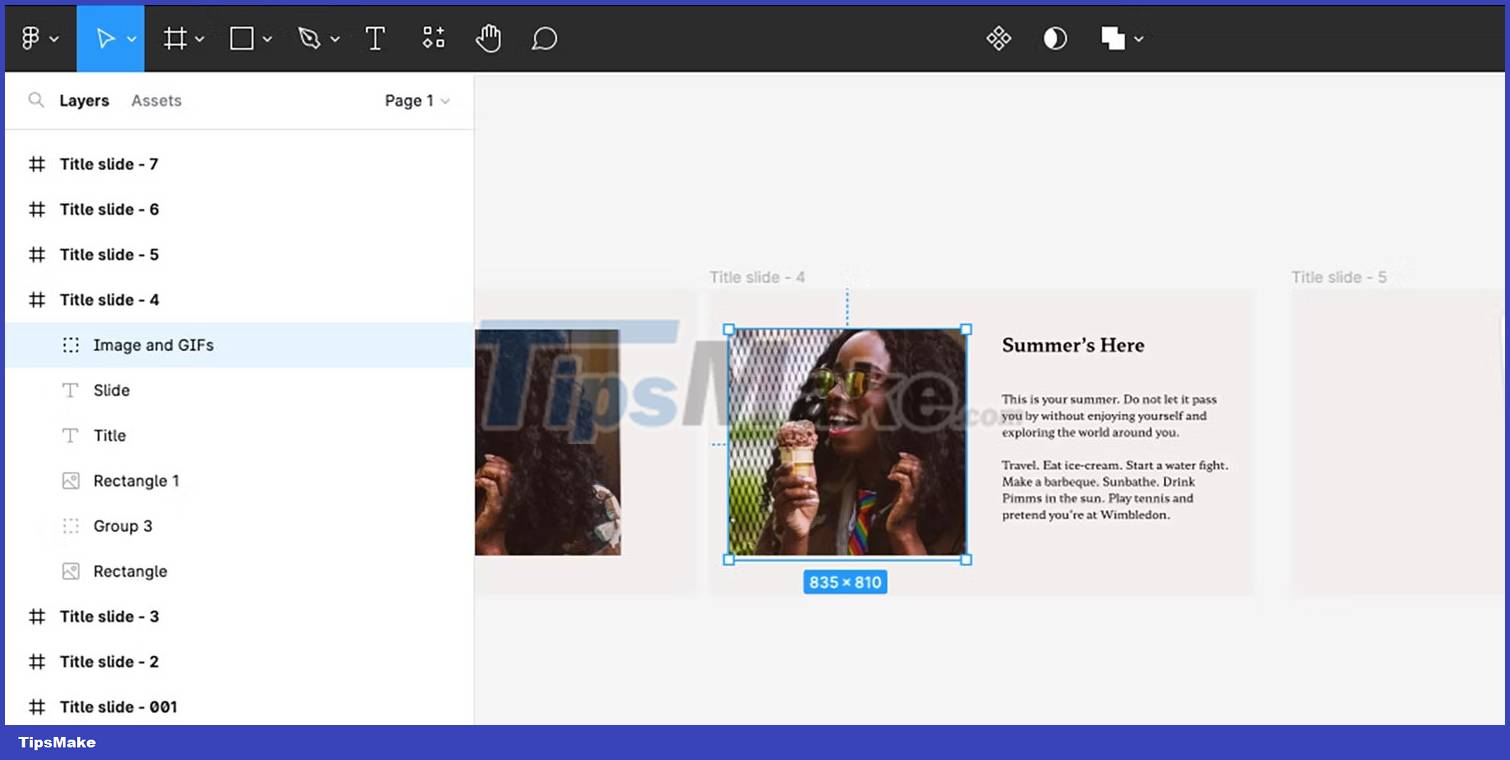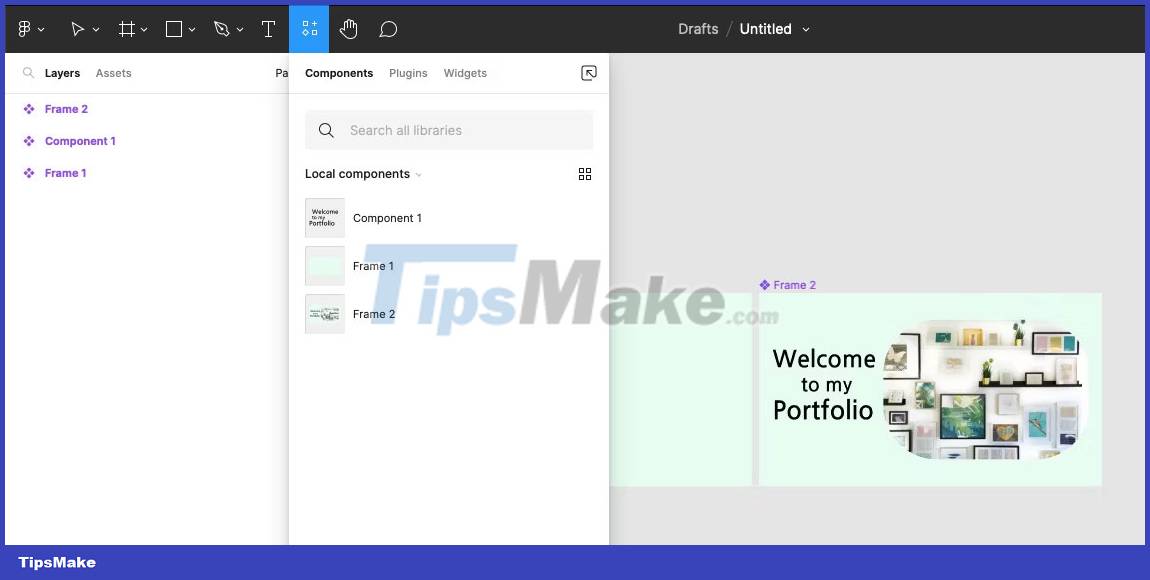11 useful Figma shortcuts to work faster
As designers, we are often looking for ways to save time, so we spend more of our precious time creating work than flipping through menus. TipsMake has put together a list of useful Figma keyboard shortcuts that help streamline your workflow.
1. Select the Scale tool
This simple one-key shortcut is a quick way to expand your items. Press the K key , then select the object you need to resize. All you need to do is click and drag an anchor point and your object will stay proportional while scaling to whatever size you need.
2. Select the Frame tool

Frame is a much used tool in Figma when creating multiple frame boards for prototype designs. Pressing F on your keyboard brings up tools, allowing you to quickly draw or size your frame.
You can draw the frame directly by clicking and dragging the cursor, or when the Frame tool is selected, you can enter your desired dimensions in the size boxes on the menu to the right.
3. Switch between Design and Prototype mode
The keyboard shortcut Shift + E allows you to switch between Design mode and Prototype mode. The same shortcut works no matter what mode you start and switch to.
Also, there are more specific keyboard shortcuts for this purpose. Alt (Windows) / Option (Mac) + 8 can be used to switch from Prototype mode to Design mode, while Alt (Windows) / Option (Mac) + 9 switch from Design mode back to Design mode Prototypes. Obviously, it's easier to press Shift + E , but it's nice to have so many options.
4. Select innermost element with one click
When designing in multiple layers or with embedded images, it can be difficult to select elements quickly. To save time clicking dozens of times to select the bottom layer, use this shortcut instead.
On a Mac, hold Cmd + Click on the element , and on Windows, Ctrl + Click . A simple shortcut saves a few minutes of mindless clicking to select the element on the bottom layer.
5. Move one level out after selecting the innermost element
Once you've finished selecting the innermost element of your design, you may realize that you want to select the element one level ahead - it's that easy. Once you've found the innermost element, press Shift + Enter to go one level back. You can do this for all other levels.
6. Collapse all layers

When designing in Figma, your layers panel will start to expand and can potentially look a bit cluttered, especially when you convert your HTML to a Figma design. To collapse layers, just press Alt + L (Windows) or Option + L (Mac) .
If you have an element selected while using this shortcut, the layer with that element will remain open. Select anywhere outside the artboard to deselect all elements and use keyboard shortcuts to collapse all layers.
7. Show or hide layout grid

Using layout grids is the best way to ensure that your designs scale well and can scale correctly for a variety of devices. While they are useful, you don't always want the grids to be visible.
Enabling and disabling layout grids on a Mac is different on Windows. On a Mac, press Ctrl + G to turn it on or off. If you are using Windows, press 3 keys; Ctrl + Shift + 4 . Although the keystrokes are different, the function is the same.
8. Put multiple photos at once in Figma

If you've designed layouts with placeholder shapes for images, inserting images one by one can be frustrating. This shortcut allows you to place multiple photos, and simply select a placeholder - or anywhere on the artboard - to place each image individually.
For Mac users, press Cmd + Shift + K to pull up the dialog window and find the image. On Windows, press Ctrl + Shift + K to find and place multiple photos in your Figma design. If you create a master template in Figma, this is a great shortcut to use.
9. Copy any image as PNG
When using images in your Figma design, you may have a variety of file formats, but perhaps your client requires PNG. You can copy any image as a PNG, regardless of its original format.
Select the image you want and press Cmd + Shift + C on Mac and Ctrl + Shift + C on Windows to copy it as PNG. You can easily use this shortcut to ensure a high standard image format, especially if you are creating a presentation using Figma.
10. Choose a color from anywhere
Eyedrop is a handy feature when you want to take color from one part of the design to another part of the design. This quick shortcut allows you to invoke the tool in seconds and pick up color from anywhere on the drawing.
On a Mac, press Cmd + C and on Windows, press Ctrl + I . Once you've pressed the shortcuts, move the eyedrop target over the color you want to use and click once to grab the color.
11. Open the Resources tab

The Resources tab is where the Components, Plugins , and Widgets menus are located . While there's no shortcut to open those menus individually, the Resources shortcut - Shift + I - still saves time. You can use the plugin to create and add models to your Figma designs.
You should read it
- 16 Useful Figma Plugins Free Downloadable
- How to create an engaging presentation using Figma
- 11 useful tips for a productive Figma workflow
- 9 best free Figma courses
- How to convert any website into a Figma design
- How to create a master template for presentations in Figma
- How to create a frosted glass effect in Figma
- Photoshop shortcuts help you work faster (part 1)
May be interested
- How to convert any website into a Figma design
 figma is a great tool that is quickly becoming a favorite of web and ux/ui designers. you can create responsive web designs quickly and easily using this free browser-based tool.
figma is a great tool that is quickly becoming a favorite of web and ux/ui designers. you can create responsive web designs quickly and easily using this free browser-based tool. - 28 Windows 11 shortcuts you should know and use often
 28 new windows 11 shortcuts in addition to familiar win 11 shortcuts will help you work faster and more efficiently.
28 new windows 11 shortcuts in addition to familiar win 11 shortcuts will help you work faster and more efficiently. - Useful shortcuts on Ubuntu 2017 you may not know yet
 ubuntu also has useful shortcuts like on windows. using the shortcut on ubuntu will help you work faster. these are the most commonly used ubuntu shortcuts that you should know when installing this operating system.
ubuntu also has useful shortcuts like on windows. using the shortcut on ubuntu will help you work faster. these are the most commonly used ubuntu shortcuts that you should know when installing this operating system. - Photoshop shortcuts help you work faster (part 2)
 after the keyboard shortcuts are useful for working with layers and selections in part 1, part 2 of the article summarizes useful photoshop shortcuts that provide quick operations with brushes, colors, and selections. choose save as well as basic image editing.
after the keyboard shortcuts are useful for working with layers and selections in part 1, part 2 of the article summarizes useful photoshop shortcuts that provide quick operations with brushes, colors, and selections. choose save as well as basic image editing. - Summary of the latest Windows 10 shortcuts
 use keyboard shortcuts to help you work faster and more efficiently on windows 10 such as interacting with the virtual desktop, opening cortana, starting the task view feature, recording the entire video activity on the application interface .....
use keyboard shortcuts to help you work faster and more efficiently on windows 10 such as interacting with the virtual desktop, opening cortana, starting the task view feature, recording the entire video activity on the application interface ..... - All Gmail shortcuts save time you should know
 using keyboard shortcuts in gmail will help you read, write, and reply to messages faster. it only takes 10 minutes to learn these gmail shortcuts and you can save dozens of hours of work each year.
using keyboard shortcuts in gmail will help you read, write, and reply to messages faster. it only takes 10 minutes to learn these gmail shortcuts and you can save dozens of hours of work each year. - Photoshop shortcuts help you work faster (part 1)
 these photoshop shortcuts will help you work faster in photoshop. here is a summary of the most useful and useful photoshop shortcuts for you!
these photoshop shortcuts will help you work faster in photoshop. here is a summary of the most useful and useful photoshop shortcuts for you! - Create shortcuts for quick actions in Word 2013
 by default, word 2013 has set up keyboard shortcuts for some commands to help you work faster. but you can still edit and create many other shortcuts for you to perform text formatting, save files and perform many other operations faster.
by default, word 2013 has set up keyboard shortcuts for some commands to help you work faster. but you can still edit and create many other shortcuts for you to perform text formatting, save files and perform many other operations faster. - Summary of new keyboard shortcuts on Windows 11 to help you work faster
 microsoft has just released a beta version of windows 11 that brings many new experiences to users. windows 11 also provides users with many new keyboard shortcuts.
microsoft has just released a beta version of windows 11 that brings many new experiences to users. windows 11 also provides users with many new keyboard shortcuts. - How to use Siri Shortcuts to manipulate quickly and smartly on iPhone
 ios 12 lets you create siri (siri shortcuts) shortcuts for commonly used tasks on iphone / ipad and make them work faster. find out more about this feature.
ios 12 lets you create siri (siri shortcuts) shortcuts for commonly used tasks on iphone / ipad and make them work faster. find out more about this feature.










 16 Useful Figma Plugins Free Downloadable
16 Useful Figma Plugins Free Downloadable Figma - Free Multimedia Design Tool
Figma - Free Multimedia Design Tool How to use the Gemoo Snap utility to take a screenshot of the computer screen
How to use the Gemoo Snap utility to take a screenshot of the computer screen 7 best FPS boosting software for Windows 10
7 best FPS boosting software for Windows 10 How to Try Bumble Premium for Free
How to Try Bumble Premium for Free PhotoRec - Tool to recover lost data
PhotoRec - Tool to recover lost data